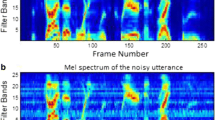Abstract
A voice activity detector (VAD) is the prerequisite for speaker recognition in real life. Currently, we deal with the VAD problem at the frame level through short time window function. However, when tackling with the VAD problem manually, we can easily pick out the speech segments containing several words. Inspired by this, we firstly use IIR filter to get the envelope of the waveform and divide the envelope into separate sound segments. And then we extract shape features from the obtained segments and use K-means to cluster the data featured by the amplitude of the wave crest to discard the silent part. Finally, we utilize other shape features to discard the noise part. The performance of our proposed VAD method has apparently surpassed the energy-based VAD and VQVAD with a relative 20% decrease in error rate, While the computation time of the proposed VAD method is only 30% less than that of VQVAD. We also get an encouraging result utilizing our VAD method for speaker recognition with about 3% average decrease in EER.
Access this chapter
Tax calculation will be finalised at checkout
Purchases are for personal use only
Preview
Unable to display preview. Download preview PDF.
Similar content being viewed by others
References
Haigh, J.A., Mason, J.S.: Robust voice activity detection using cepstral features. In: IEEE Region 10 Conference on Computer, Communication, Control and Power Engineering, pp. 321–324. IEEE Press, New York (1993)
Boll, S.: Suppression of acoustic noise in speech using spectral subtraction. IEEE Transactions on Acoustics, Speech and Signal Processing 27, 113–120 (1979)
Vaseghi, S.V.: Spectral Subtraction. In: Advanced Signal Processing and Digital Noise Reduction, pp. 242–260. Springer, Heidelberg (1996)
Kinnunen, T., Rajan, P.: A practical, self-adaptive voice activity detector for speaker verification with noise telephone and microphone data. In: IEEE International Conference on Acoustics, Speech, and Signal Processing (ICASSP), pp. 7229–7233. IEEE Press, New York (2013)
Sohn, J., Kim, N.S., Sung, W.: A statistical model-based voice activity detection. IEEE on Signal Processing Letters 6, 1–3 (1999)
Sun, H.W., Ma, B., Li, H.Z.: Frame selection of interview channel for NIST speaker recognition evaluation. In: 7th International Symposium on Chinese Spoken Language Processing (ISCSLP), pp. 305–308. IEEE Press, New York (2010)
Burget, L., Matejka, P., Schwarz, P.: etal: Analysis of feature extraction and channel compensation in a GMM speaker recognition system. IEEE Transactions on Audio, Speech, and Language Processing 15, 1979–1986 (2007)
Martin, R.: Noise power spectral density estimation based on optimal smoothing and minimum statistics. IEEE Transactions on Speech and Audio Processing 9, 504–512 (2001)
VOICEBOX: Speech Processing Toolbox for MATLAB, http://www.ee.ic.ac.uk/hp/staff/dmb/voicebox/voicebox.htmlAppendix
ALIZE: Open Source platform for biometrics authentification, http://mistral.univ-avignon.fr/index_en.html
Author information
Authors and Affiliations
Editor information
Editors and Affiliations
Rights and permissions
Copyright information
© 2014 Springer International Publishing Switzerland
About this paper
Cite this paper
Zhao, Q., Yang, Y., Li, H. (2014). A Novel and Efficient Voice Activity Detector Using Shape Features of Speech Wave. In: Sun, Z., Shan, S., Sang, H., Zhou, J., Wang, Y., Yuan, W. (eds) Biometric Recognition. CCBR 2014. Lecture Notes in Computer Science, vol 8833. Springer, Cham. https://doi.org/10.1007/978-3-319-12484-1_42
Download citation
DOI: https://doi.org/10.1007/978-3-319-12484-1_42
Publisher Name: Springer, Cham
Print ISBN: 978-3-319-12483-4
Online ISBN: 978-3-319-12484-1
eBook Packages: Computer ScienceComputer Science (R0)




